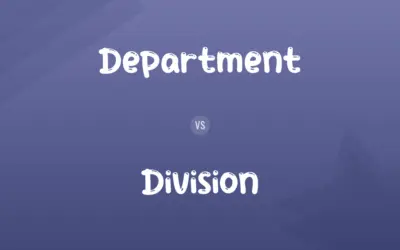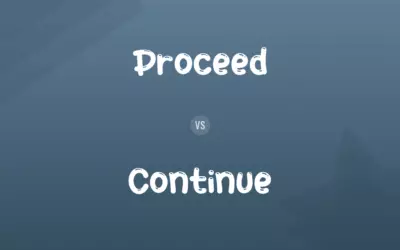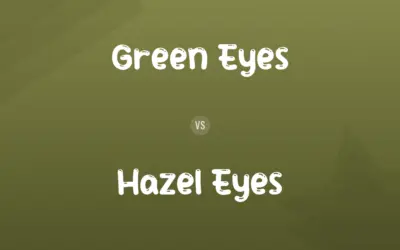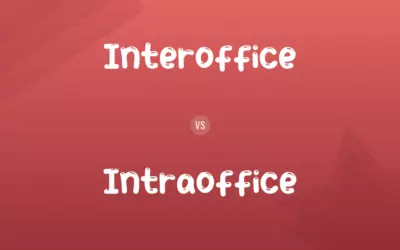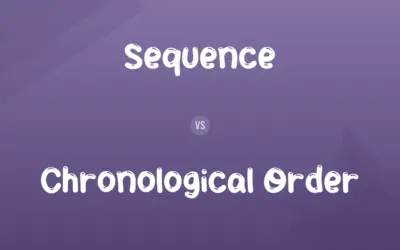Bifocal Lenses vs. Varifocal Lenses: Difference and Comparison
By Muazma Batool & Muneeza Rehman — Published on February 26, 2024
Bifocal lenses contain two distinct optical powers for near and distance vision, separated by a visible line. Varifocal lenses offer a seamless transition across multiple vision zones without lines, providing clear vision at all distances.
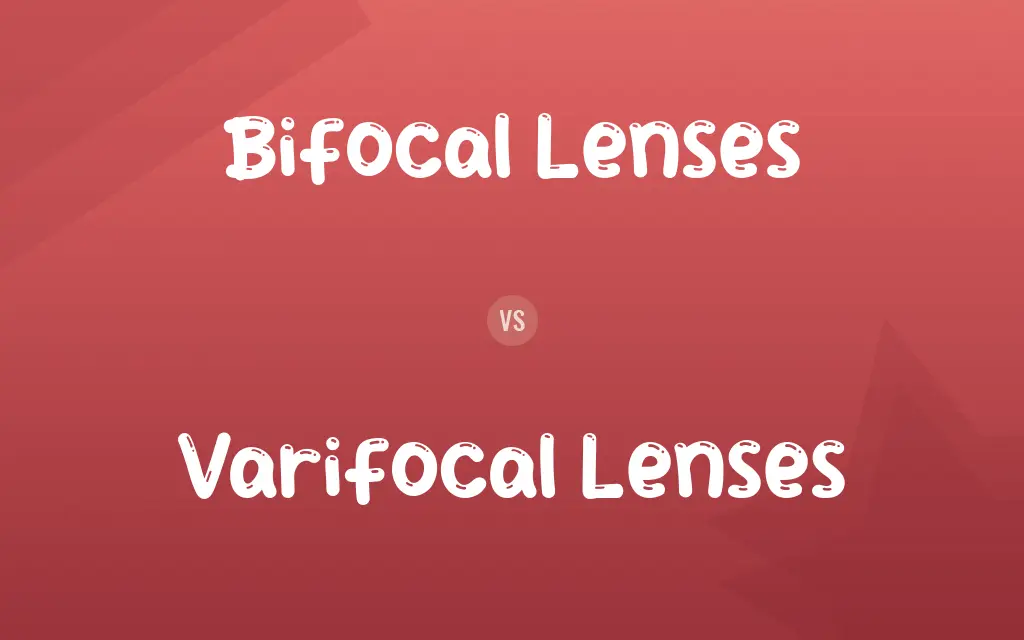
Difference Between Bifocal Lenses and Varifocal Lenses
Bifocal lenses are designed with two distinct sections: the upper part for distance vision and the lower part for near vision, traditionally separated by a visible line. This design is ideal for individuals who need correction for both nearsightedness and presbyopia, offering a clear, though abrupt, switch between viewing distances. Varifocal lenses, also known as progressive lenses, incorporate multiple optical powers that gradually change from the top to the bottom of the lens. This progression provides the wearer with the ability to see clearly at intermediate distances as well, essentially covering near, intermediate, and far vision without any demarcation lines.
Muazma Batool
Feb 26, 2024
The transition between different vision zones in varifocal lenses is smooth, eliminating the jump experienced with bifocals when the eye moves from one section to another. However, adjusting to varifocal lenses can be challenging for some, as the lens requires precise positioning and movement of the head and eyes to find the optimal focus for different distances. Bifocals, being simpler in design, typically have a shorter adjustment period.
Muazma Batool
Feb 26, 2024
Varifocal lenses are preferred for their aesthetic appeal and functionality, offering a lens free from lines, which can be less stigmatizing and provide a more youthful appearance. Bifocals, on the other hand, are often less expensive than varifocals and can be a practical choice for those who primarily need clear vision for two distinct distances and prefer a straightforward solution.
Muazma Batool
Feb 26, 2024
Choosing between bifocal and varifocal lenses depends on individual needs, lifestyle, and budget. While bifocals might be suitable for someone with specific near and far vision requirements, varifocals offer a more versatile solution for those who also need clear intermediate vision and prefer a lens without visible lines.
Olivia
Feb 26, 2024
Bifocal Lenses vs. Varifocal Lenses Comparison Chart
Optical Zones
Two distinct zones (near and far)
Multiple zones (near, intermediate, far)
Muazma Batool
Feb 26, 2024
Adjustment Period
Generally shorter
May be longer due to the need to find the right angle for each distance
Muazma Batool
Feb 26, 2024
Ideal For
Individuals with specific near and far vision needs
Those requiring clear vision at all distances, including intermediate
Levi
Feb 26, 2024
Usage Ease
Simpler to use with no need to find the right angle
Requires learning to look through the right part of the lens
Muazma Batool
Feb 26, 2024
Bifocal Lenses vs. Varifocal Lenses Definitions
◉Bifocal Lenses
Cost-effective for dual vision correction.
Opting for bifocal lenses was an economical choice for his vision needs.
Kaitlyn
Feb 22, 2024
◉Varifocal Lenses
Require a period of adjustment to use effectively.
It took her a few weeks to adjust to the varifocal lenses’ viewing zones.
Muazma Batool
Feb 22, 2024
◉Bifocal Lenses
Easy transition for first-time wearers.
She adapted quickly to her bifocal lenses, appreciating the distinct viewing areas.
Muazma Batool
Feb 22, 2024
◉Varifocal Lenses
Provide a seamless transition between multiple distances.
With varifocal lenses, he no longer experienced the jump when shifting gaze from near to far objects.
Muazma Batool
Feb 22, 2024
◉Bifocal Lenses
Have a visible line dividing the lens.
The line in her bifocal lenses clearly demarcated the reading section.
Muazma Batool
Feb 22, 2024
◉Varifocal Lenses
Offer an aesthetically pleasing look without lines.
She preferred varifocal lenses for their line-free appearance.
William
Feb 22, 2024
◉Bifocal Lenses
Lenses with two prescriptions for near and far vision.
He switched to bifocal lenses to avoid carrying separate reading glasses.
Muazma Batool
Feb 22, 2024
◉Varifocal Lenses
Ideal for a broad range of vision needs.
Varifocal lenses supported his active lifestyle, from reading to hiking.
William
Feb 22, 2024
◉Bifocal Lenses
Offer a clear vision for distance and reading.
Bifocal lenses made both driving and reading comfortable for him.
Muazma Batool
Feb 22, 2024
◉Varifocal Lenses
Lenses that gradually change in power from top to bottom.
Varifocal lenses eliminated her need for multiple pairs of glasses.
Muazma Batool
Feb 22, 2024
Bifocal Lenses vs. Varifocal Lenses Frequently Asked Questions
Who should choose varifocal lenses?
Those requiring clear vision at near, intermediate, and far distances who value aesthetics and functionality without the interruption of lines.
Muazma Batool
Feb 26, 2024
Can varifocal lenses cause dizziness?
Some wearers may initially experience dizziness or discomfort as they adjust to looking through different parts of the lens for various distances.
Kaitlyn
Feb 26, 2024
What are bifocal lenses?
Bifocal lenses contain two optical powers for near and distance vision, separated by a visible line.
Muazma Batool
Feb 26, 2024
What are varifocal lenses?
Varifocal lenses, or progressives, offer a gradual change in optical power from top to bottom, providing clear vision at all distances without visible lines.
Muazma Batool
Feb 26, 2024
Who should choose bifocal lenses?
Individuals who need correction for both near and far vision and prefer a simple, cost-effective solution.
Muazma Batool
Feb 26, 2024
Do varifocal lenses have more glare than bifocals?
Glare is not inherently more common with varifocals; however, the quality of the lens coating can affect glare reduction in both bifocal and varifocal lenses.
Leo
Feb 26, 2024
How long does it take to adjust to varifocal lenses?
Adjustment to varifocal lenses can vary, typically ranging from a few days to a month, as wearers learn to navigate the different vision zones.
Muazma Batool
Feb 26, 2024
What activities are varifocal lenses good for?
Varifocal lenses are versatile, ideal for activities requiring clear vision at varying distances, such as driving, reading, and using computers.
Muazma Batool
Feb 26, 2024
Can I drive with bifocal lenses?
Yes, bifocal lenses can be used for driving, with the top section aiding distance vision. However, some may find varifocal lenses more comfortable for seeing the dashboard and road simultaneously.
Levi
Feb 26, 2024
Why do varifocal lenses cost more than bifocal lenses?
Varifocal lenses are more expensive due to their complex design and manufacturing process, which allows for a seamless transition between vision zones.
William
Feb 26, 2024
Content Creators
Written by
Muazma BatoolAs a content editor, Muazma Batool is not just a grammar guru but a creative mastermind who breathes life into every word. With an eagle eye for detail and a passion for storytelling, she transforms bland text into engaging content that captivates audiences and drives results.
Co-written by
Muneeza RehmanAt Comparisons.wiki, Muneeza skillfully navigates the vast sea of information, ensuring clarity and accuracy as the lead content editor. With a keen eye for detail, she curates every comparison to enlighten and engage readers.




